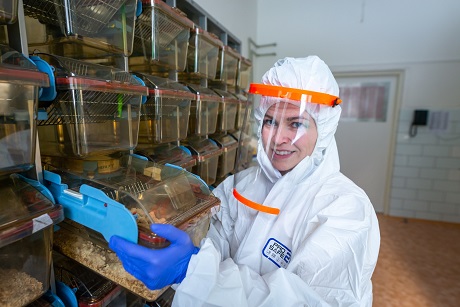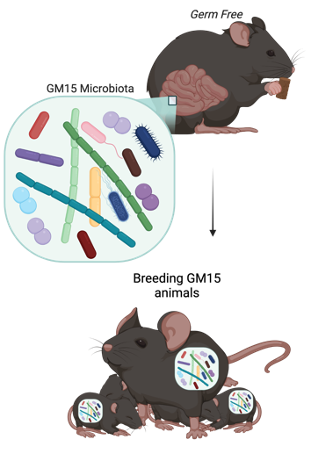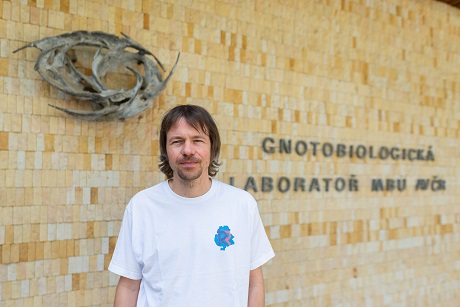
Special mouse model helps reveal how exactly the gut microbiome works
28. 02. 2022
There is no doubt nowadays that gut microorganisms influence human health. Scientists are trying to find out how communities of bacteria are formed and what impact they have on the functioning of the body and the development of certain diseases. They have therefore developed a laboratory mouse model in which they can precisely control the composition of gut bacteria. They have published their results in the Nature Communications journal.
Part of the research took place in the laboratory of gnotobiology of the Institute of Microbiology of the Czech Academy of Sciences (CAS), located in Nový Hrádek in the Orlické Mountains. The laboratory is exceptional for breeding unique germ-free laboratory animals. They have no detectable bacteria in their digestive tract and live in a completely sterile environment in hermetically sealed isolators - they are therefore a unique model for biomedical research. They can be "seeded" with a selected strain of bacteria or bacterial mixture and tested to see if they worsen or improve the course of a model disease.

The laboratory mice live in Nový Hrádek in a completely sterile environment.
Mouse GM15
Currently, experts have developed a new animal model called "GnotoMice15" (GM15) for research purposes. The mouse has an artificial gut microbiota consisting of 15 bacterial strains originally isolated from the gut of a normal laboratory mouse.
The advantage of these bacterial strains is that they have a fully deciphered genome and detailed functions. This allows scientists to control the composition of the gut bacteria in detail and manipulate it in different ways.
In the GM15 model, the minimal mouse microbiota is implanted into an originally germ-free animal and is transferable to offspring.
"The microbiota used is resistant even to small changes in the mice's diet related to different breeding practices. In addition, despite its simplicity, it can also recapitulate the functions of more complex gut bacteria by effectively restoring a range of biological processes that are disrupted in individuals without a gut microbiota," explains Martin Schwarzer.
Treating mice more gently
The new mouse model is capable of efficient transfer between different experimental breeds. It can thus facilitate the implementation of various studies that examine the links between the biology of the gut microorganisms and its interaction with the host.
"In practice, this could mean that laboratories in the UK or the Czech Republic, for example, order a mouse line that will be standardised both genetically and in terms of the microbiome. Ultimately, this would lead to better reproducibility of results between laboratories and also to fewer animals being used," adds Martin Schwarzer.

Martin Schwarzer
Like pieces of a building kit
The modularity of bacterial mixtures allows experts to add or remove bacterial strains and to observe how they affect the other bacteria in the mixture and the functioning of the host itself. Scientists compare the defined gut microbiome to a child's building kit.
"We have a pile of pieces - individual gut bacteria - and we pick them out and put together a model - the gut microbiome. We know what each piece is, and when we add it to the model we can see how it works with the other pieces, i.e. whether it is important for the final function or not. We can change, add or remove pieces and observe how the resulting model affects the host," explains Martin Schwarzer.
It is this modularity that opens up amazing possibilities that will contribute to understanding how gut bacteria work with each other and how they affect the host.
Experts from the French Institute of Functional Genomics and the French Technological Research Institute BioAster participated in the research alongside scientists from the Institute of Microbiology of the CAS.
Text: Leona Matušková, Division of External Relations, CAS Centre of Administration and Operations
Photos: Jana Plavec, Division of External Relations, CAS Centre of Administration and Operations; Jessika Consuegra & Filipe De Vadder
Read also
- The CAS suspends or ends scientific activities in Russia and Belarus
- The Czech Academy of Sciences supports scientists in Ukraine
- One hundred years of polarography
- A revolutionary patent: a cheap and safe high-capacity battery
- Astronomy helps find oil and gas deposits
- The Czech scientist’s biochip proved to detect coronavirus fast and reliably
- Auxin: the transport mechanism of a key plant hormone refined
- ERC grants for 3 experts from the Czech Academy of Sciences
- On the way to the Sun and Jupiter
- Hidden warriors. Women who were actively involved in World War II
The Czech Academy of Sciences (the CAS)
The mission of the CAS
The primary mission of the CAS is to conduct research in a broad spectrum of natural, technical and social sciences as well as humanities. This research aims to advance progress of scientific knowledge at the international level, considering, however, the specific needs of the Czech society and the national culture.
President of the CAS
Prof. Eva Zažímalová has started her second term of office in May 2021. She is a respected scientist, and a Professor of Plant Anatomy and Physiology.
She is also a part of GCSA of the EU.